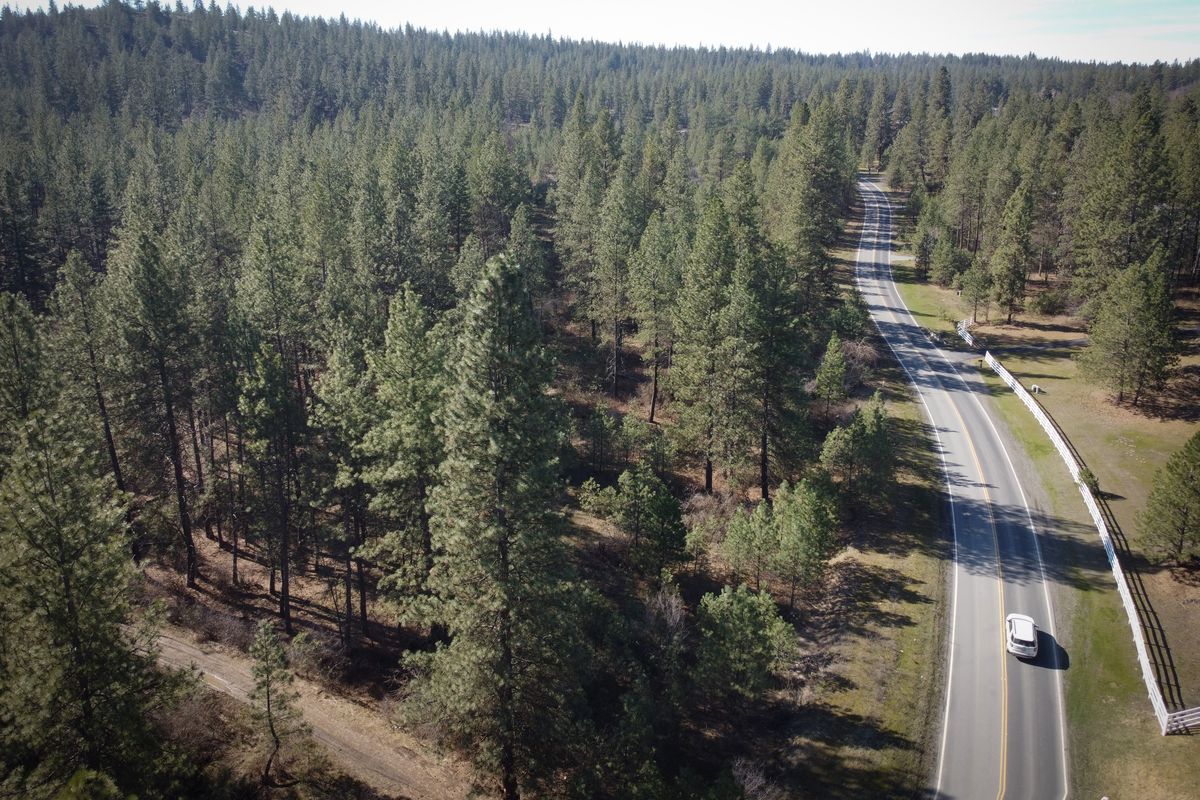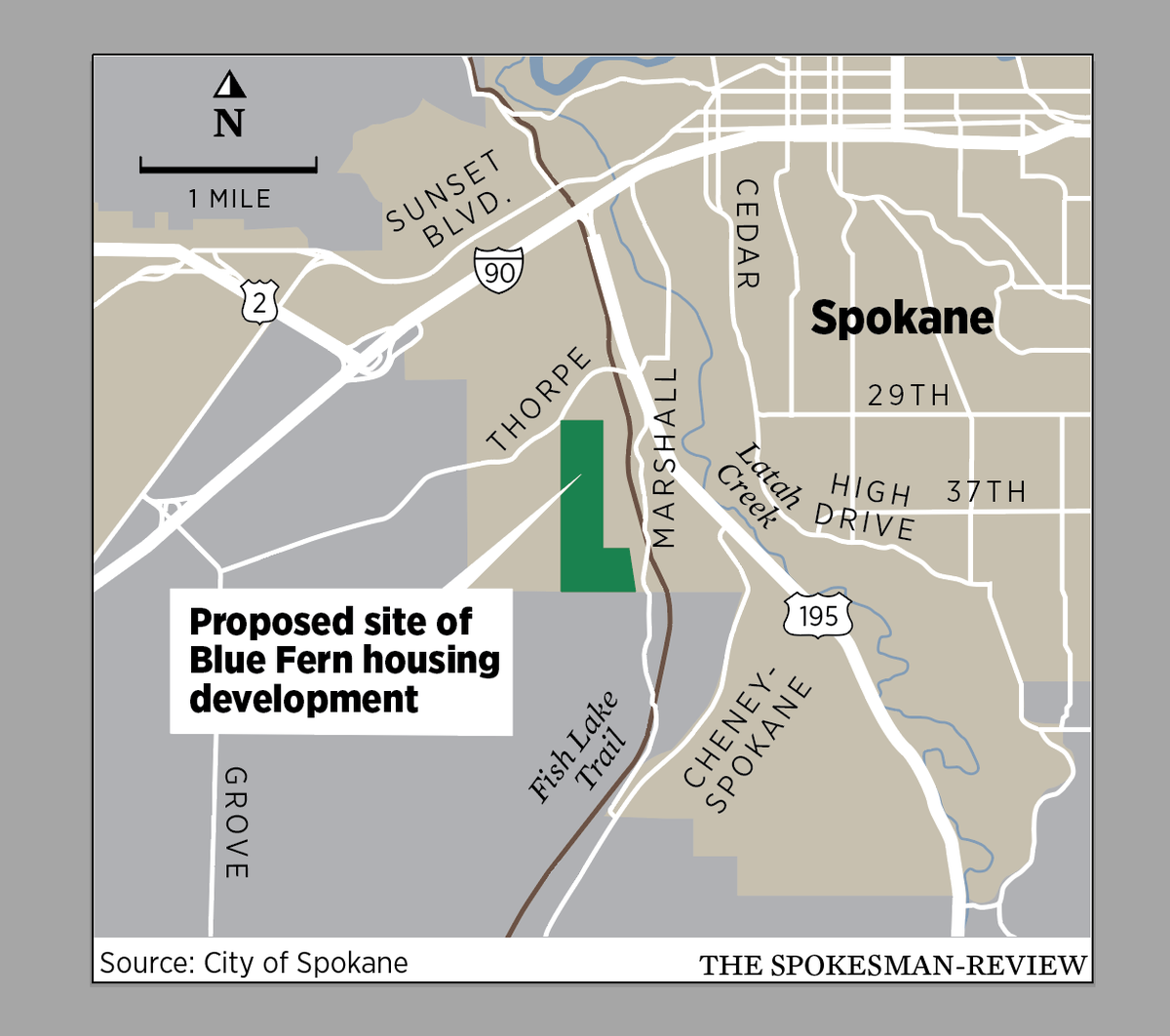Conservationists make another last ditch effort to halt transfer of Thorpe Road woodland to developer
Conservationists hope to stop as many as 1,000 homes from being built on this undeveloped land, left, shown March 24, 2024, along Thorpe Road south of Spokane. (Jesse Tinsley/THE SPOKESMAN-REVIEW)
Conservationists are making a final attempt to get the state Department of Natural Resources to halt plans to transfer around 200 acres of woodland in western Spokane to a developer that wants to build as many as 1,000 homes.
Attempts late last year to get the state agency to delay the transfer of the Thorpe Road land appeared to fail after the board of the Department of Natural Resources voted on Jan. 7 to move forward with the transfer. But activists have discovered a clause that allows that agreement to be terminated by April 6, and hope to appeal once more to the board during an April 1 meeting, arguing the process was rushed and the board was provided a flawed review of the ecological value of the property.
“What we’re asking the board to do is … to step back and make sure they’ve got this right,” said Tom Uniack, executive director for state conservation group Washington Wild.
The request to reconsider has been included in the board’s information packet for the April 1 meeting but has not yet been added as an agenda item, according to Ryan Rodruck, a communications official for the state agency. Rodruck largely declined to comment on the particular complaints of opponents of the transfer.
“The process was done in accordance with DNR policy and state law, including all the required public outreach and a public meeting,” Rodruck said.
The land in question is a small part of the Department of Natural Resources’ Common Schools Trust fund, 3 million acres of land managed by the agency to produce nontax revenue that pays for, among other things, building schools. This revenue is typically generated through leases, including leasing woodlands to logging companies.
The Thorpe Road property is relatively unproductive, however, and currently costs the Department of Natural Resources more than it brings in due to dumping, trespassing and encampments, according to agency analysis provided to the board during the Jan. 7 meeting.
The city of Spokane’s parks department applied last year to a competitive program in which DNR considers transferring ownership of its trust land and is compensated by the state, not the recipient – meaning Spokane, if it had been successful, could have received the land at no cost to the city.
The city had proposed folding the land into its parks portfolio, conserving much of it as wildland.
But among the 30 properties considered last year through DNR’s trust land transfer program, there was only enough funding from the state legislature for eight. Spokane’s application ranked 18th, a ranking local conservationists and City Councilman Paul Dillon have argued was flawed due to an inadequate consideration of the land’s natural resources and a lack of tribal input.
Instead, DNR, under the leadership of then-Lands Commissioner Hilary Franz, moved to quickly exchange the land to Redmond-based developer Blue Fern Management, which proposed building around 1,000 homes there in what it calls the Latah Park development. In exchange for the Thorpe Road land, which was valued at around $8 million, as well as another $7 million of agency funds, Blue Fern agreed to trade them a 4-acre commercial property in Whatcom County with a Haggen grocery store.
Conservation activists attempted to slow or stop the transfer, arguing the wooded area contains geological, ecological and cultural features that are increasingly rare in city limits and would be lost under the construction. Several testified to the state agency board in opposition to the transfer, and the Spokane City Council voted in December to formally ask for a delay to pursue alternatives.
Their efforts were to no avail, however, and the DNR board voted unanimously on Jan. 7 to approve the trade with Blue Fern.
Opponents argue many aspects of this deal were flawed, including the speed with which it was approved, the valuation of the Whatcom County land, the agency’s analysis that the land had little ecological value and the agency’s presentation to the board.
“It was pretty obvious, observing the actions of the department… that the outgoing commissioner just really wanted this thing done,” said Dan Bernardo, who served on the DNR board from 2005 to 2013 while working as the dean of the College of Agricultural, Human and Natural Resource Sciences at Washington State University.
“I don’t know the reason for that, but typically they vet things very well, and if there’s any sort of pushback or controversy, they double back on it, and that just didn’t happen in this case,” Bernardo added. “Which is kind of strange, because the trust, there’s a sizable sum of money in the trust, and it’s not something that would need to be executed quickly.”
Blue Fern CEO Benjamin Paulus largely declined to comment on the specifics of the last-ditch appeal to DNR, except to say his company was following the agency’s lead in the proposed exchange.
“DNR has a very, very stringent process for how they do exchanges,” he said. “We’re following their lead.”
Local conservationists Jeff Lambert and Brian Muegge argue that the agency’s presentation to the board prior to the Jan. 7 vote was flawed. They argue that a letter from the Department of Fish and Wildlife submitted during the 14-day comment period, which states development would “decrease the viability” of a local herd of mule deer and recommended avoiding impacts to wildlife and vegetation by “keeping the Thorpe Property in its natural state,” was not presented to the board.
“It makes me wonder why some of this information was excluded from the proceedings, and what else was excluded,” Lambert said.
The Department of Natural Resources’ own analysis of the property showed that “four rare plant communities were observed but were not considered to be large enough or in good enough ecological condition to be added to the Natural Heritage Program’s database of significant biodiversity.” The report also notes that the survey was done too late in the year to fully document rare plants on the site, which Lambert pointed to as evidence of a rushed and incomplete process.
Lambert also argued that the site could be remediated.
Uniack questioned the viability of the Whatcom County property that DNR would receive in exchange for the Thorpe Road parcel, noting that the Haggen grocery store was among those listed to be sold to C&S Wholesale Grocers as part of the failed Kroger/Safeway/Albertson’s merger. C&S has committed that “no stores will close as a result of the merger,” according to the companies’ merger website, Cascadia Daily News reported last July.
However, regulators opposed to the merger have questioned the viability of C&S if it competes with a merged Kroger/Albertsons/Safeway.
The conservationists also claimed that it would be unprecedented for a property identified for the trust land transfer program to be then removed from the list for sale, arguing it should instead remain on the list pending future funds earmarked by the state legislature.
Lambert noted that DNR recently reformed their process for trust land transfer and believes that mistakes were made due to inexperience with the new procedure.
“I don’t find that to be very damning,” Lambert said. “However, I do think that if they’re gaining experience in how to manage a complicated selection process, it makes sense not to quickly eliminate properties from a very important trust land transfer program.”
While the makeup of DNR’s board has not changed since their Jan. 7 vote, the conservationist activists say they hope to find an ally in the state’s new Public Lands Commissioner Dave Upthegrove.
Beyond the potential loss of a wildlife corridor and woods, Dillon has previously raised concerns about adding potentially more than a thousand people – and their cars – to the Latah Valley. New development is already paused in the area after the City Council approved a moratorium in May, citing failing roads, insufficient emergency vehicle access, poor evacuation routes and a desire to address those issues before allowing new growth.
It’s a concern that has only become more relevant in recent days.
Earlier this month, the state Department of Transportation warned it may soon block access to U.S. 195 from Thorpe Road if major, expensive infrastructure improvements aren’t made prior to other development in the area. They point to another property, directly adjacent to the site of the proposed Latah Park development, where Blue Fern is much closer to building another 1,000 homes.

